

Move your mouse over the pictures to see the names of the various features. For larger-scale pictures of parts of the mare see Page 2 and for large-scale mosics see Page 3.
Mare Frigoris is a long, thin mare stretching right across the northern part of the Moon. Its exact length depends on where you consider it starts and finishes but is of the order of 1,500 Km long by about 200 Km wide. It may be considered to start at the crater Harpalus in the west, the region west of Harpalus being Sinus Roris. In the east it extends to the craters Atlas and Keldysh, but connects with Lacus Mortis further south.
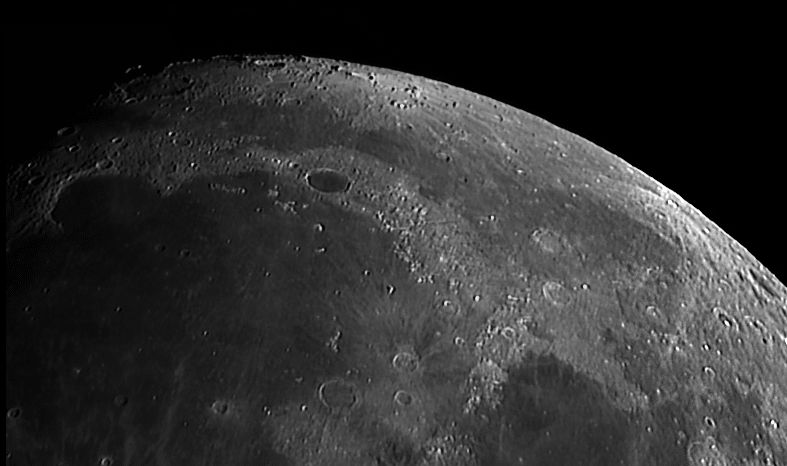
|
This is a mosaic of two images of this area taken using my LX200 with my 0.33 focal reducer to give a wide view. It was taken on 9th December 2008 when the Moon was 11.4 days old. Date and Time: 9th December 2008 20:31 and 20:37 UT Camera: Modified ToUcam 840K Telescope: LX200 at prime focus Capture: K3CCDTools. High gamma, 1/250", 0% gain, 499 frames Processing: Registax. 100 frames stacked. Wavelet 1-3 = 10, histogram 0-200, gamma 1.2, contrast 80 |
Mare Frigoris is a most unusual mare. All the other maria are roughly circular because they result from lava filling large impact basins. When a meteorite impacts the Moon it forms a crater which is circular. The size of the crater depends on the size of the impacting meteorite but is invariably much larger than the meteorite. The form of the crater depends on its size, from tiny pits, through craters with terraced walls and central mountains, to the largest structures, the impact basins, such as Serenitatis, Tranquilitatis, and Crisium (image 1). All the big impact basins on the near side of the Moon are ancient, battered by later impacts of smaller objects, and filled with lava. The later history has largely obliterated or covered up the features of such basins. Fortunately there is a comparatively pristine example of an impact basin on the far side of the Moon which was fully recognised only when space-craft images became available. This is the Orientale Basin just over the western limb which is shown in Image 2 (courtesy of Clemantine and the VMA). At least three rings can be seen in the overhead view, one surrounds the central dark patch, with the second a little further out; then is a region that seems comparatively flat followed by a third outer ring. (Put your mouse over the image to see the rings outlined. Please ignore the white line; it is the limb as seen from Earth, but I could find no way to remove it.)
 |
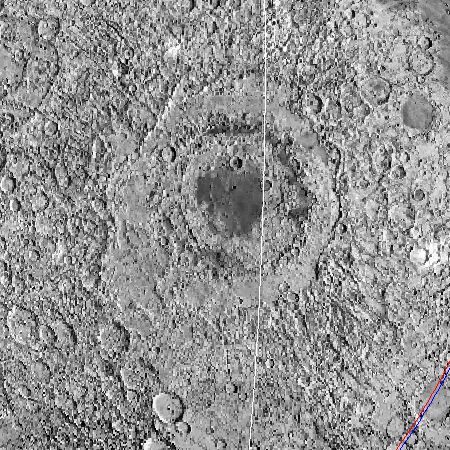 |
Image 1 Image 2
If you look at Image 2, you will notice a dark area between the first and the second ring. This is Lacus Veris and is a pool of lava which has collected between the two rings. So could Mare Frigoris be the same kind of feature around the Imbrium basin?
Jim Mosher's remarkable Lunar Terminator Visualisation Tool (LTVT) can do a great deal more than visualise the terminator. It can show a part of the Moon seen from any direction, and it can draw circles that are circles on the Moon irrespective of the view. Using this tool I constructed Image 3, below, which uses the Clemantine mosaic from the VMA viewed from above. The inner circle was constructed by fitting it, by eye, to the Carpathian and Apennine mountain chains, and you can see that is continues through the Alps and the Jura. The outer circle has the same centre but a radius about 75% greater. Then in Image 4 I have drawn the same circles on my photograph.
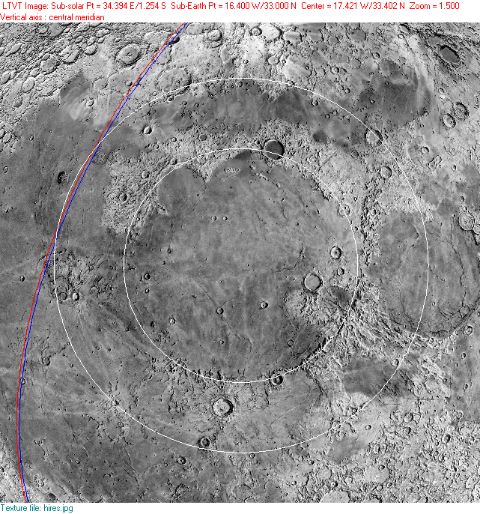 |
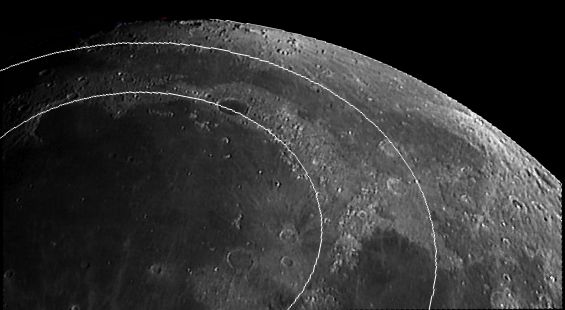 |
Image 3 Image 4
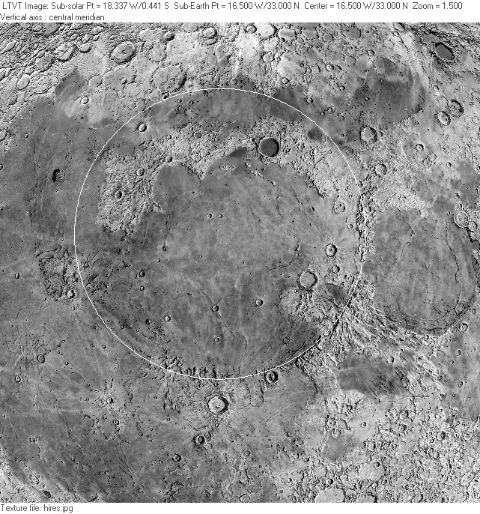 It has been said (The Modern Moon page 68) that a circle defined by the Carpathians and Apennines passes along the northern shore of Mare Frigoris. I have to say that I don't see this. It is true that the Apennines do not show a true circular arc so where the circle goes in the north does depend on just how you fit it to the Apennines. It seems to me that the southern two thirds of them do fit a pretty good arc, and the northern part deviates towards the Caucasus mountains, which are tangential to neither the Imbrium nor the Serentatis basins. I have tried to fit a circle to the Apennines alone and this is shown on the right. In my view this circle does not fit the basin as well as the smaller circle in Image 3; it passes outside the Carpathians, and it passes through the Caucasus, which do not appear to be tangential to the Imbrium basin. Although the circle passes outside of the Carpathians, it passes inside of the northern rim of the Mare Frigoris.
It has been said (The Modern Moon page 68) that a circle defined by the Carpathians and Apennines passes along the northern shore of Mare Frigoris. I have to say that I don't see this. It is true that the Apennines do not show a true circular arc so where the circle goes in the north does depend on just how you fit it to the Apennines. It seems to me that the southern two thirds of them do fit a pretty good arc, and the northern part deviates towards the Caucasus mountains, which are tangential to neither the Imbrium nor the Serentatis basins. I have tried to fit a circle to the Apennines alone and this is shown on the right. In my view this circle does not fit the basin as well as the smaller circle in Image 3; it passes outside the Carpathians, and it passes through the Caucasus, which do not appear to be tangential to the Imbrium basin. Although the circle passes outside of the Carpathians, it passes inside of the northern rim of the Mare Frigoris.
In my opinion, the inner circle of Image 3 represents the better fitting to the mountains that surround Mare Imbrium. Having said that, there are features that would not be taken as typical of a basin rim. Compared to the Apennines, the Alps are a very modest set of mountains, the Jura are usually taken to be the rim of the crater that forms the Sinus Iridum, and the circle is missing entirely in the west. Normally basin have multiple rings but, in the case of Imbrium, any rings inside that defined by the Apennines are almost certainly hidden beneath the lava (those odd isolated mountains, Mons Pico and Montes Recti, are sometimes thought to be the tips of a ring poking above the lava). Does an outer ring, as indicated in Image 3, actually exist? I have to say that there is virtually no evidence that it does. The only part that shows any signs is that part to the north of Mare Frigoris, which looks much more like cratered highlands rather than part of any ring, and I am trying to account for Mare Frigoris, so I cannot use it to justify a ring of mountains for which there is no real evidence elsewhere. I would like to think it is real and accounts for Mare Frigoris, but it is difficult to do so without further evidence of its existence. It remains an interesting, if currently unprovable, speculation.
Home Page 2 Page 3 NW Quadrant